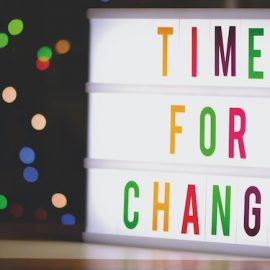

This article is an excerpt from the Shortform book guide to "The Great Mental Models Volume 2" by Shane Parrish and Rhiannon Beaubien. Shortform has the world's best summaries and analyses of books you should be reading.
Like this article? Sign up for a free trial here.
Do gun buyback programs work? How did Barack Obama accelerate his 2008 presidential campaign?
Change is hard. But, The Great Mental Models Volume 2 provides two models from science that can help us initiate and accelerate change in our own lives and even in the world around us. Authors Rhiannon Beaubien and Shane Parrish discuss what we can learn from incentives and catalysts.
Keep reading to learn how to bring about change in yourself and others.
Making Change Easier
Various factors make it hard to accomplish change. In some cases, simply being aware of these factors can help us adjust them. Likewise, there are other principles we can capitalize on that serve to encourage and even accelerate change—these are incentives and catalysts. Let’s look at how understanding these forces can help us learn how to bring about change.
Incentives
Beaubien and Parrish explain that, when we’re aiming for change on a personal or social level, it’s crucial to understand incentives—the factors that shape our behaviors by rewarding or punishing them. The authors explain that, biologically, we’re so sensitive to incentives that just the hope of a reward or the fear of punishment can dictate how we behave.
Though incentives are key to survival (for example, they teach us to seek out food and avoid danger), Beaubien and Parrish point out that they frequently go wrong. For one thing, many behaviors have short-term and long-term consequences—and, if we don’t notice the long-term consequences, we have a hard time making the best choices. For example, if it’s bedtime, but you’re stuck into a Netflix binge, the short-term rewards of watching another episode or two might easily outweigh the long-term effects of not getting enough sleep.
(Shortform note: Our ability to weigh incentives is further complicated by anticipation. In Atomic Habits, Clear argues that the brain is wired to experience more pleasure from craving something than from actually having that thing. This makes sense from a biological perspective—if we only felt pleasure from eating food, we might not have enough motivation to obtain food in the first place. Unfortunately, this extra weight on anticipation makes it hard to judge just how rewarding a behavior actually is. As Judson Brewer argues in Unwinding Anxiety, our brains do a poor job separating a behavior itself from all the ancillary factors (like anticipation) surrounding the behavior.)
Similarly, Beaubien and Parrish point out that poorly designed incentives can lead to undesirable behavior. For example, gun buyback programs—where police offer cash in exchange for unwanted or illegal weapons, no questions asked—are intended to reduce crime by removing guns from circulation. But, in practice, these programs often lead to absurd results such as gun dealers turning in large numbers of weapons for a profit or criminals turning in guns and using the proceeds to buy better ones. (Shortform note: This phenomenon is known as perverse incentives, and it affects everything from economic policy to environmental law to education.)
In short, Beaubien and Parrish suggest that you should be cautious about incentives—take a close look at what’s motivating your behavior and determine whether that motivation lines up with your long-term goals and values. The authors argue that exercising this caution will lead you to make better decisions and make you less likely to be manipulated by others, such as advertisers and politicians.
(Shortform note: On the positive side, you can use carefully chosen incentives to encourage behaviors that do line up with your goals and values. For example, Clear suggests linking desired behaviors with small rewards—for example, if you want to cut your caffeine consumption, then every time you skip going to the coffee shop, you could stick the money you would have spent into an account dedicated to buying something you want (say, a new video game). Doing so gives you a new incentive—whenever you feel tempted by the coffee, you’ll remember your video game fund and have an easier time choosing your intended behavior.)
Catalysts
Whereas incentives can help you direct behaviors to initiate change, Beaubien and Parrish argue that catalysts can accelerate change at the social level. They explain that, in chemistry, a catalyst is a substance that increases the rate of a chemical reaction without being consumed itself by the reaction. For example, when left to its own devices, hydrogen peroxide (H2O2) slowly decomposes into water and oxygen—a reaction so slow that H2O2 is readily available for disinfecting and other applications. But, if you add manganese dioxide (MnO2) to H2O2, the MnO2 greatly accelerates the reaction, causing the oxygen to bubble off quickly, leaving behind just water and unchanged MnO2.
Beaubien and Parrish argue that chemical catalysts such as MnO2 are metaphors for factors that accelerate social change. For example, some technologies work as catalysts by offering new ways of spreading ideas and mobilizing them into action. During his 2008 presidential campaign, Barack Obama and his team used relatively new social media platforms (Facebook was only three years old) to raise funds and spread grassroots enthusiasm for his candidacy.
Likewise, Beaubien and Parrish say that influential people can serve as catalysts by making new ideas or behaviors more attractive by association. For example, former U.S. First Lady Jacqueline Kennedy Onassis is credited with popularizing a number of fashions that became trends in the 1960s and 1970s.
(Shortform note: In practice, new technologies and influential people often go hand-in-hand. In Crossing the Chasm, Geoffrey Moore argues that new technologies often die because they appeal to a small group of early adopters, but never catch on with a larger customer base. To appeal to this larger customer base, Moore argues that you need to use your reputation with early adopters and major product vendors to convince potential customers of your product’s value. In this case, the early adopters and vendors serve as catalysts for your product’s wider success. Though Moore’s discussion is specific to product life cycles, we can infer that a similar principle applies to the adoption of new ideas (such as political or social movements).)
As Beaubien and Parrish point out, in each of these cases, social catalysts don’t cause change that wouldn’t have happened otherwise—instead, they accelerate change that’s already underway (just as MnO2 accelerates the reaction H2O2 is already undergoing). In other words, Obama capitalized on an existing trend toward progressive politics and Kennedy’s clothes took deliberate influence from established French styles. In both cases, however, the catalyst arguably caused the change to happen faster and more effectively than it would have otherwise.
| How To Catalyze a Social Movement In The Tipping Point, Malcolm Gladwell argues that you can deliberately use social catalysts to help spread a message or a movement faster than it would spread on its own. Gladwell identifies three types of people who function as social catalysts: Connectors are people who have numerous acquaintances across a variety of social circles. If you get a connector on your side, your message will spread to more people faster, including people you might not have been able to reach on your own. Mavens are respected for their expertise and judgment. If a maven promotes your cause, people are more likely to listen than if “just anyone” repeated the message. Salesmen excel at persuading others. If they support your message, they’ll be able to convince other people to support it—and act on it—as well. Gladwell’s point is that if you’re trying to instigate social change, getting one or more of these personality types on your side will catalyze your cause. Similarly, he suggests that you make your message “sticky”—that is, memorable and actionable—and alter the social environment to make it more likely that your message catches on. This latter suggestion in particular is similar to Beaubien and Parrish’s suggestion to make change easier by reducing friction. |

———End of Preview———
Like what you just read? Read the rest of the world's best book summary and analysis of Shane Parrish and Rhiannon Beaubien's "The Great Mental Models Volume 2" at Shortform.
Here's what you'll find in our full The Great Mental Models Volume 2 summary:
- How you can understand anything by learning a finite set of rules and patterns
- How physics can help you improve interpersonal interactions
- Why making a major life change is so difficult






